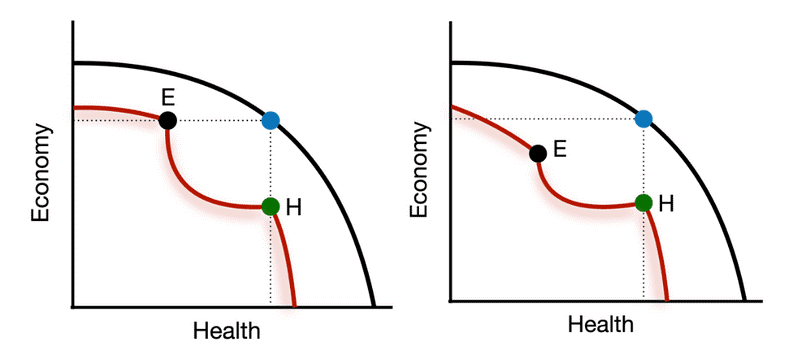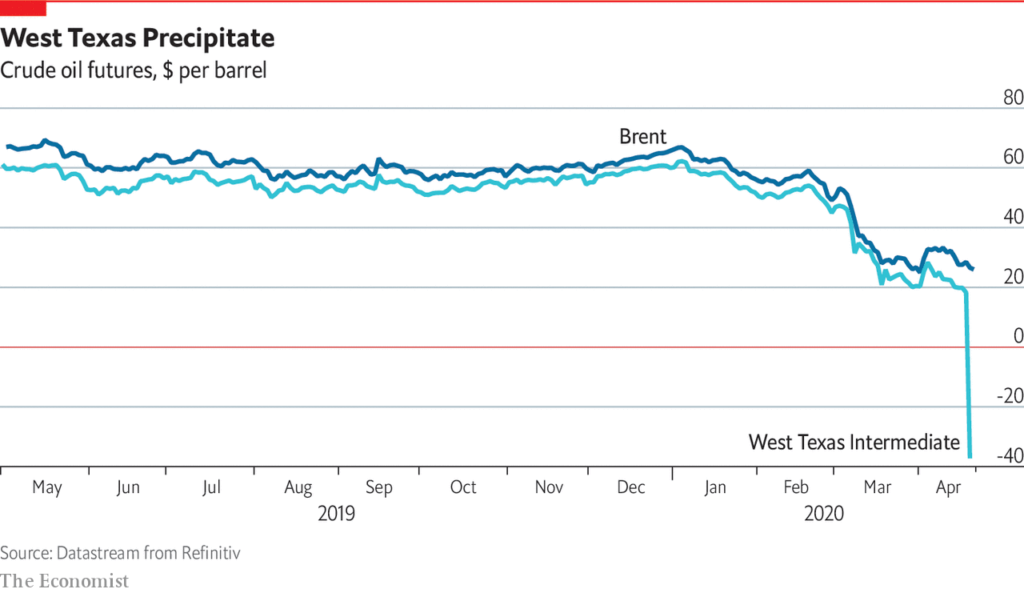Measuring Benefits and Costs, Roadmaps to Reopening (and what’s with negative oil prices?)
This week we address the issue of the (potential) tradeoffs between the economy and health. We kick off with Joshua Gans’ introductory chapter from his forthcoming book that uses a production possibilities model where the shock from the epidemic introduces a convexity into the frontier, upending our traditional thinking. We will likely revisit Gans when we talk about innovation and the development of medical technologies.
The Conover and Thomson-DeVeaux pieces provide a pretty interesting overview on how quantifying the willingness to pay to reduce mortality risk translates into the unfortunately-titled value of a statistical life (VSL).
Matthew Yglesias summarizes a poll from the IGM forum on economists’ views of moving forward, and Tyler Cowen at Marginal Revolution pulls together a number of sources addressing these questions. This tees up two research papers that provide some preliminary estimates along these fronts that suggest we should sit tight for a bit. The slides for 4/23 walk through how the Imperial College risk estimates (Ferguson et al., 2020) are integrated with the VSL concept to give a perspective on the value of social distancing and safe-at-home type measures.
Moving forward, we have a series of papers about moving forward. Ed Yong at The Atlantic warns us that we are in this for the long haul: ““I think people haven’t understood that this isn’t about the next couple of weeks. This is about the next two years.” That notwithstanding, we have two roadmaps for reopening — one from Harvard and one from the American Enterprise Institute. The overlap is considerable.
Finally this week, we saw a bizarre bout of negative oil prices. I suggested we drain the Viking pool and store the oil in there for a bit, but that didn’t go over as well as I thought with the swimmers. James Hamilton knows more about oil markets than most people, and he provides us some insight into what just happened.
Benefits and Costs
- Joshua Gans, “Health Before Wealth,” Chapter 1 of Economics in the Age of COVID-19, MIT Press (especially the technical interlude)
- Chris Conover, “How Economists Calculate the Costs and Benefits of COVID-19 Lockdowns,” Forbes, March 27, 2020
- Amelia Thomson-DeVeaux “What Should the Government Spend to Save a Life?” FiveThirtyEight, March 27, 2020 (note, it’s not really the government, per se; a superior title is, “What Costs is the Polity Willing to Incur to Reduce Mortality Risk?)
- Matthew Yglesias, “”Top economists warn ending social distancing too soon would only hurt the economy,” Vox, March 29, 2020
- Tyler Cowen, “Re-starting the economy,” Marginal Revolution blog, April 15, 2020
- Michael Greenstone and Vishan Nigam. “Does Social Distancing Matter?” University of Chicago, Becker Friedman Institute for Economics Working Paper 2020-26 (2020). (summary at Pro-Market blog)
- Linda Thunstrom, Stephen Newbold, David Finnoff, Madison Ashworth, and Jason F. Shogren, “The Benefits and Costs of Using Social Distancing to Flatten the Curve for COVID-19,” Forthcoming Journal of Benefit-Cost Analysis.
Moving Forward
- Ed Yong, “Our Pandemic Summer,” Atlantic Monthly, April 14, 2020
- Danielle Allen et al., Roadmap to Pandemic Resilience: Massive Scale Testing, Tracing, and Supported Isolation (TTSI) as the Path to Pandemic Resilience for a Free Society, Edmond J. Safra Center for Ethics at Harvard University, April 20, 2020
- Scott Gottleib et al., National Coronavirus Response: A Road Map to Reopening, American Enterprise Institute, March 28, 2020
Negative Oil Prices
- James Hamilton, “Negative Oil Prices,” Econbrowser, April 21, 2020 (for those of you who wanted a finance course!)

